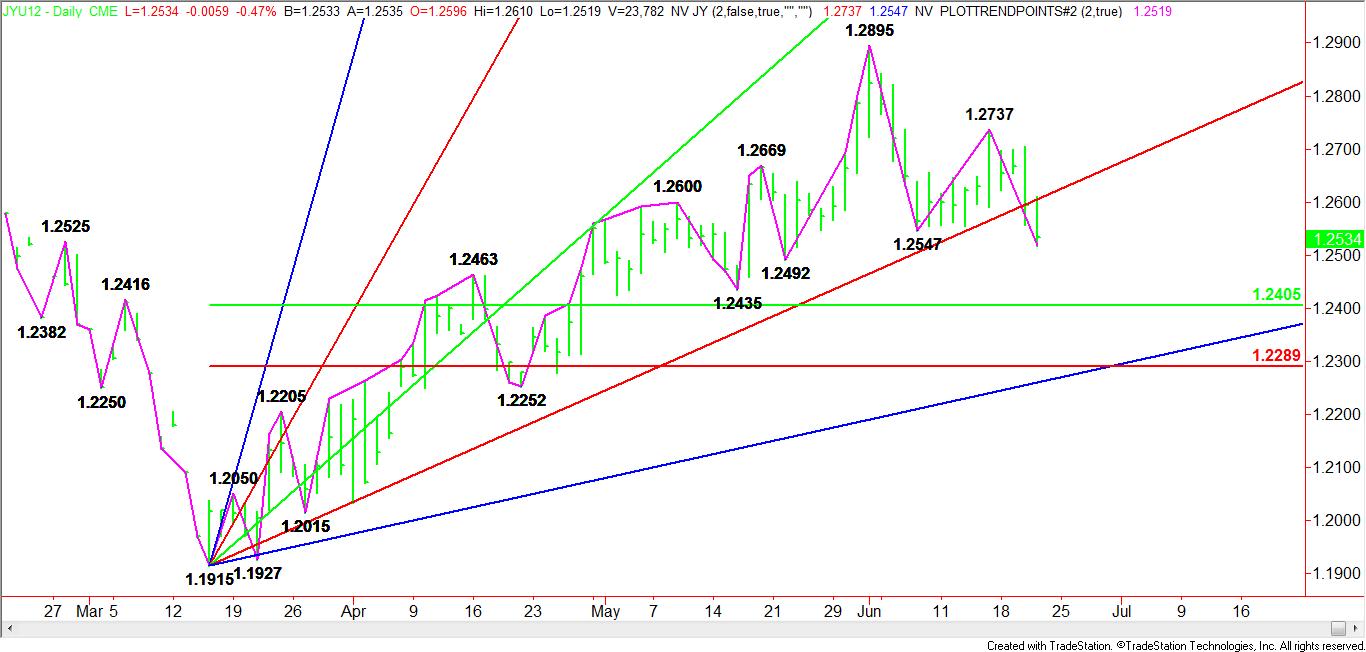The U.S. Dollar is extending gains against the September Japanese Yen this morning after weak U.S. economic data pressured riskier assets. Heavy selling in the global equity markets is sending traders into the safety of the greenback.
Yesterday’s Fed announcement is also contributing to the weakness. The U.S. Dollar actually began showing strength on Wednesday after the U.S. Federal Reserve said it would extend its holdings of long-term government bonds using the program called Operation Twist. Additionally, Fed Chairman Ben Bernanke left the door open for additional stimulus if necessary, citing expectations of a poor employment outlook and weaker housing market.
Traders also remain skeptical about Europe believing that Spanish banks are a major problem with investor confidence at this time. The results of an audit of the Spanish banking system due later Thursday are expected to show the need for capital. Some estimates show the need for $76 billion to $101 billion in recapitalization.
Besides the worsening situation in Europe, traders are also reacting to the drop in manufacturing activity as reported by the Federal Reserve Bank of Philadelphia. This report said manufacturing activity fell to negative 16.6 in June, its lowest level since August 2011, from negative 5.8 in May. Finally, news that manufacturing in China showed contraction in June may have set the tone for the day in overnight trading.
Technically, the September Japanese Yen broke through uptrending Gann angle support from the 1.1915 bottom posted in March. This support line is at 1.2605. Additionally, the futures contract took out a swing bottom at 1.2547, changing the main trend to down on the daily chart.
Based on the main range of 1.1915 to 1.2895, expectations are for a potential break into the retracement zone at 1.2405 to 1.2289.
Traders should continue to look for more downside pressure as long as investors continue to dump higher yielding assets in favor of the U.S. Dollar.
- English (UK)
- English (India)
- English (Canada)
- English (Australia)
- English (South Africa)
- English (Philippines)
- English (Nigeria)
- Deutsch
- Español (España)
- Español (México)
- Français
- Italiano
- Nederlands
- Português (Portugal)
- Polski
- Português (Brasil)
- Русский
- Türkçe
- العربية
- Ελληνικά
- Svenska
- Suomi
- עברית
- 日本語
- 한국어
- 简体中文
- 繁體中文
- Bahasa Indonesia
- Bahasa Melayu
- ไทย
- Tiếng Việt
- हिंदी
Japanese Yen Trend Turns Lower After Weak U.S. Economic Data
Published 06/22/2012, 01:04 AM
Updated 05/14/2017, 06:45 AM
Japanese Yen Trend Turns Lower After Weak U.S. Economic Data
Latest comments
Loading next article…
Install Our App
Risk Disclosure: Trading in financial instruments and/or cryptocurrencies involves high risks including the risk of losing some, or all, of your investment amount, and may not be suitable for all investors. Prices of cryptocurrencies are extremely volatile and may be affected by external factors such as financial, regulatory or political events. Trading on margin increases the financial risks.
Before deciding to trade in financial instrument or cryptocurrencies you should be fully informed of the risks and costs associated with trading the financial markets, carefully consider your investment objectives, level of experience, and risk appetite, and seek professional advice where needed.
Fusion Media would like to remind you that the data contained in this website is not necessarily real-time nor accurate. The data and prices on the website are not necessarily provided by any market or exchange, but may be provided by market makers, and so prices may not be accurate and may differ from the actual price at any given market, meaning prices are indicative and not appropriate for trading purposes. Fusion Media and any provider of the data contained in this website will not accept liability for any loss or damage as a result of your trading, or your reliance on the information contained within this website.
It is prohibited to use, store, reproduce, display, modify, transmit or distribute the data contained in this website without the explicit prior written permission of Fusion Media and/or the data provider. All intellectual property rights are reserved by the providers and/or the exchange providing the data contained in this website.
Fusion Media may be compensated by the advertisers that appear on the website, based on your interaction with the advertisements or advertisers.
Before deciding to trade in financial instrument or cryptocurrencies you should be fully informed of the risks and costs associated with trading the financial markets, carefully consider your investment objectives, level of experience, and risk appetite, and seek professional advice where needed.
Fusion Media would like to remind you that the data contained in this website is not necessarily real-time nor accurate. The data and prices on the website are not necessarily provided by any market or exchange, but may be provided by market makers, and so prices may not be accurate and may differ from the actual price at any given market, meaning prices are indicative and not appropriate for trading purposes. Fusion Media and any provider of the data contained in this website will not accept liability for any loss or damage as a result of your trading, or your reliance on the information contained within this website.
It is prohibited to use, store, reproduce, display, modify, transmit or distribute the data contained in this website without the explicit prior written permission of Fusion Media and/or the data provider. All intellectual property rights are reserved by the providers and/or the exchange providing the data contained in this website.
Fusion Media may be compensated by the advertisers that appear on the website, based on your interaction with the advertisements or advertisers.
© 2007-2024 - Fusion Media Limited. All Rights Reserved.
